Ministry of Jal Shakti
67th EC of NMCG Approves Major Research Projects to Strengthen Scientific River Management
Posted On:
17 NOV 2025 3:00PM by PIB Delhi
The 67th Executive Committee (EC) meeting of the National Mission for Clean Ganga (NMCG), was chaired by Director General Shri. Rajeev Kumar Mital. The EC deliberated on various issues for the rejuvenation of river Ganga, focusing on pollution abatement and research. EC also focused on rejuvenation of the Yamuna in Delhi through safe and efficient conveyance of treated sewage to the river, and educational public outreach to school children in Delhi.
The meeting was attended by senior officials, including Shri Gaurav Masaldan (Joint Secretary & Financial Adviser, DoWR), Shri Nalin Srivastava (Deputy Director General, NMCG), Shri Anup Kumar Srivastava (Executive Director, Technical), Shri S.P. Vashisth (Executive Director, Admin), Shri Brijendra Swaroop (Executive Director, Projects), Shri Bhaskar Dasgupta (Executive Director, Finance), Shri Prabhash Kumar (Project Director, Uttar Pradesh SMCG), Ms. Nandini Ghosh (Project Director, West Bengal SPMG), along with senior officers of NMCG and participating states.
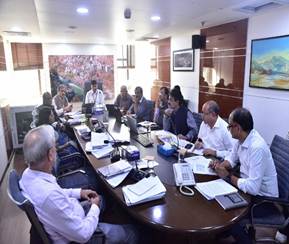
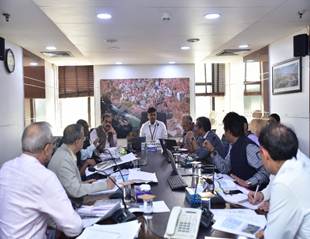
The Executive Committee placed a strong emphasis on research-led river rejuvenation, approving major research projects aimed at strengthening scientific understanding and data-driven planning across the Ganga basin. These initiatives span critical areas—from Monitoring of Key Himalayan Ganga Headstream glaciers, Digital Twin development for the Ganga, and high-resolution SONAR-based riverbed surveys, to managed aquifer recharge via paleochannels and the creation of a historic geospatial river database. Together, these research interventions mark a significant advancement in NMCG’s strategy to integrate cutting-edge science, AI tools, and real-time hydrological modelling into long-term river basin management.


The approvals reflect NMCG’s commitment to ensuring that policy decisions and restoration measures are guided by robust scientific evidence, enabling precision planning for climate resilience, groundwater security, sediment management, and river health across the Ganga basin.
As a major initiative towards pollution abatement in West Bengal, EC approved the project for the Interception & Diversion of drains and the construction of STPs for pollution abatement of the River Mahananda in Siliguri, costing ₹361.86 crore. This project comprises 25 I&D structures, 4 lifting stations, two STPs of 27 MLD and 22 MLD, and an extensive network of rising mains and I&D lines. The project will be implemented on a Hybrid Annuity-based PPP model. Together, these initiatives will significantly improve urban sanitation systems and reduce pollution loads entering the rivers in West Bengal.

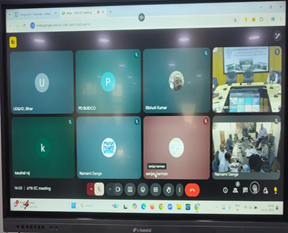
The EC approved the Conveyance of Treated Sewage from Coronation Pillar STP to the River Yamuna. The proposal aims to ensure the safe and efficient conveyance of treated sewage from the Coronation Pillar STP to the River Yamuna, thereby improving the river’s water quality and supporting the ongoing efforts of the Yamuna Action Plan. The project includes key components such as tapping of untreated sewage from the Jahangirpuri drain, construction of new pumping stations, laying of rising mains and RCC channels, creation of truss bridges for drain crossings, and conveyance infrastructure for treated effluent.
The Executive Committee approved the project on Glaciers and Glacier Melt Runoff Changes and Their Linkage to the Hydro-climatic and Topographic Context in the Upper Ganga Basin at a cost of ₹3.98 crore. To be implemented by the National Institute of Hydrology, Roorkee, the study will examine glacier retreat, changing snow cover, and their impact on melt-runoff in the Upper Ganga Basin. Using field observations, remote sensing, and a coupled modelling framework, the project will assess long-term glacier behaviour, runoff changes, and associated risks such as flash floods and GLOFs. It also approved the SONAR-based Bathymetric Survey of the Ganga River from Bijnor to Ballia at an estimated cost of over 3 crore, covering 1,100 km. The project aims to generate a high-resolution, SONAR-based underwater topographic baseline to support sediment management, hydrodynamic modelling, environmental-flow assessment, and long-term restoration planning under the Namami Gange programme.
Map showing depth of water of 10cm interval at 10m spacing and contour at 30 cm interval in Upper Ganga Canal
|
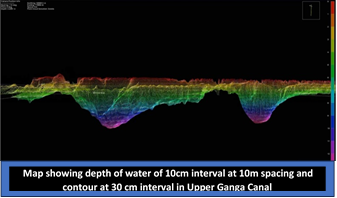
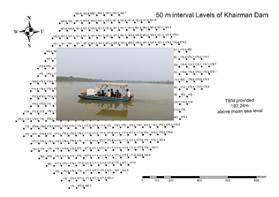

The Executive Committee approved the project on ‘Managed Aquifer Recharge (MAR) over discovered paleochannels in the Ganga–Yamuna Doab (Prayagraj–Kanpur stretch)’ at a total cost of ₹242.56 lakh. The study aims to identify suitable government land sites and construct scientifically designed MAR structures, such as recharge pits and shafts, along the paleochannel between Kaushambi and Kanpur. The project includes installing monitoring systems like DWLRs at six locations and assessing groundwater recharge impacts over two hydrological cycles. The Executive Committee (EC) approved the proposal titled Towards Intelligent River Basin Management: A Digital Twin and Water Cycle Atlas for the Ganga Basin using Hydrological Modeling, AI, and Satellite Remote Sensing at a total estimated cost of ₹3.31 crore. The project aims to develop an advanced Digital Twin and Water Cycle Atlas for the Ganga River Basin by leveraging AI, satellite remote sensing, and hydrological modeling for real-time, data-driven river basin management. Approval was granted for the Digitization and Geospatial Database of Historical Maps of the Ganga Basin, costing ₹2.62 crore. The project includes the identification and digitization of historical maps (pre-1900 to post-1950), creation of a GIS-based database, a secure geo-portal, and analytical assessment of river morphology and floodplain changes.

The EC approved the ‘Youth for Ganga, Youth for Yamuna’ initiative amounting to ₹39.37 lakh, aiming to sensitize over 2.5 lakh youth across at least 200 schools in Delhi–NCR fostering awareness and responsibility towards river conservation. The programme envisions the formation of River Youth Clubs, encourage positive behavioral changes among youth regarding water usage, and enhance Namami Gange outreach. Appraised by IIPA, the project will be completed in six months.
Through these approvals, the EC has paved the way for improved water management, strengthened monitoring systems, and enhanced scientific capabilities crucial for the rejuvenation of the Ganga.
***
ND
(Release ID: 2190772)
Visitor Counter : 637